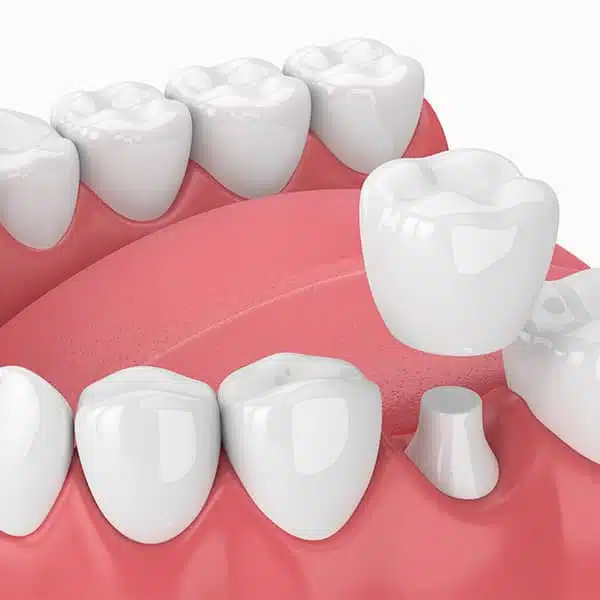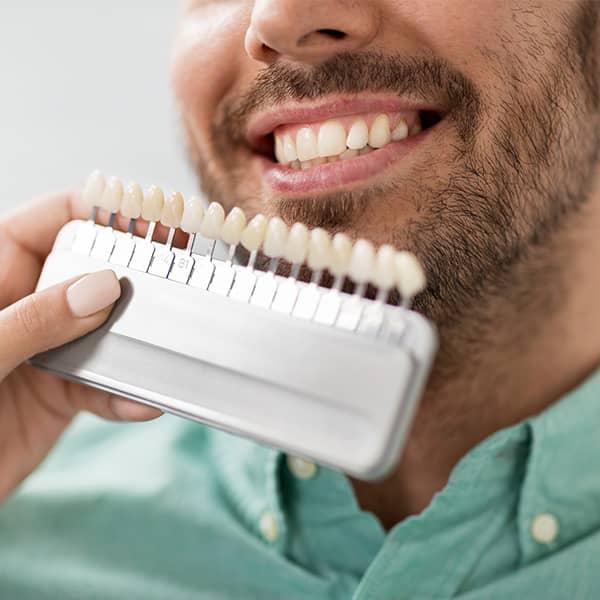Home / Dental Services / Dental Crowns
Dental Crowns Miami, FL
Dental crowns are used to cover teeth that have decayed or damaged enamel. Crowns aren’t just cosmetic enhancements, as they can prevent tooth decay, protect against future damage, and even help restore chewing function. If you’ve got a cracked or chipped tooth, then a crown may be exactly what you need to fix it. In this article, we’ll explain why crowns are important and talk about the benefits of having one fitted. We’ll also go over how you can get a crown from Gallardo Periodontics & Implant Dentistry in Miami, Florida.
Benefits of Dental Crown
Getting a dental crown, also called a cap, is a common dental procedure that offers a number of benefits. From improving the appearance of a damaged tooth to restoring its functionality, a crown is a versatile and effective treatment option.
01
Restore Damaged Teeth
Crowns are the perfect solution for cracked, chipped, or decayed teeth. They protect against further damage and restore the tooth’s natural chewability.
02
Strengthen Weak Teeth
Dental caps also strengthen teeth that have been weakened by decay or injury, thus helping to prevent future problems.
03
Enhance Cosmetic Appearance
Get a stunningly beautiful smile with dental caps! They’ll make your teeth look perfect by restoring their shape and color.
Gallardo Periodontics & Implant Dentistry in the Miami area offers premium dental care, including state-of-the-art dental caps, to help our clients preserve and enhance their smiles.
What are Dental Crowns?
Sometimes called a tooth cap, a permanent crown is a dental restoration secured over a natural tooth to function as a replacement for the original tooth structure. A dental cap can also be placed on an implant to replace a missing tooth altogether. The cap is attached to the implant, which is fixed into the jawbone, with a metal screw. Each crown is designed specifically so that it matches the rest of the teeth in shape and color.


Why are Crowns Placed?
Any change to a tooth can alter your bite wear pattern or cause stress on your other teeth. Teeth with large fillings, root canals, and damaged teeth are often weaker than intact teeth and are more prone to further damage.
Crowns are a form of restoration that mimics the natural structure of your teeth. A crown can help to prevent tooth loss by simply acting as a protective covering. Alternatively, when placed on an implant, it replaces the part of the natural tooth above the gumline. People who have gum disease may require additional periodontal work prior to receiving a dental crown.
Candidates for Dental Crowns Services
Candidates for crowns need one of two procedures, depending on the particular condition.
Dental Capping
A crown over a natural tooth is an ideal solution for dental restoration when the tooth has experienced structural loss. Each tooth plays a crucial role in the mouth by distributing the forces from biting and chewing and also when speaking.
For different reasons, such as damage or prior dental work, a tooth may crack, fracture, or become eroded over time. Significant tooth decay might also necessitate a crown. A crown can also be performed for cosmetic reasons to cover an existing tooth that is misshapen or discolored with a more aesthetically pleasing tooth.
Tooth Replacement
If you have lost a tooth, you can opt to get a dental implant, which consists of three components: a screw, an abutment or attachment to the artificial tooth, and the crown. Anyone who has suffered tooth loss and seeks replacement is a candidate for dental caps, whether as part of an implant system or within a dental bridge. A bridge typically consists of three or more crowns that are connected to provide additional area stability for one or more missing teeth.
The Dental Crown Consultation
Patients must consider the cost of the various materials
Getting a crown fitted can be discussed during a visit to the Gallardo Periodontics & Implant Dentistry in Miami, FL. A crown can be fitted if a specialist recommends the treatment or if you are seeking a cosmetic solution to an unattractive tooth.
Your dentist or periodontist generally begins by reviewing your dental records. They may request updated X-rays if needed. An impression of your teeth will be created so that the partnering dental laboratory can create dental caps that naturally match your other teeth.
At the consultation, you will learn about the different types of crowns offered. Your practitioner may have a preferred material due to higher success rates, but you will also be asked about your preferences. Common materials used for crowns are as follows:
- Gold
- Porcelain fused to metal
- Porcelain/Ceramic
- Zirconia
- E- MAX (composed of a glass-ceramic)
The cost of the various materials, their longevity, the placement of the crown, and other important factors will all be discussed with you during your appointment.
Preparing a Tooth for a Dental Crown Appointment Today
Generally, the various types of crowns require the same preparation. A crown is customized to match your other teeth to ensure that it is undetectable when you smile.
Typically, fitting a dental cap requires two visits to the dental office. During the first appointment, the dentist will modify the natural tooth.
The new structure—the crown—will look like a tooth and have a similar size as your other teeth. Because of this, the damaged tooth must be reduced in size so that the crown can fit over it.
So, your natural tooth will be ground down to make it smaller with a sanding process. Typically, one-third of the tooth will be removed from each side as well as from the biting surface. In some cases, there will be little or no sensitivity during this process because the nerve has already been removed from the tooth (such as during root canal treatment), but anesthesia injections may still be provided for your comfort.
After the natural tooth has been prepared, a temporary crown, typically made of acrylic, will be fitted over the abraded tooth and secured with a water-based glue. Usually, your dental professional will tell you to avoid very crunchy or chewy foods to prevent any movement of the temporary crown. You will have this temporary crown for 2–3 weeks until the permanent crown has been created to fit on top of the prepared tooth.
Explanation of the Dental Cap Procedure
At the second dental appointment, the temporary crown will be replaced with the permanent one. Your mouth will be anesthetized, and your dentist may utilize dental tools and agents to remove the temporary crown.
Your dentist will then prepare the tooth for the final step, which is the placement of the permanent crown. All excess glue and cement will be removed from the initial replacement, then new binding material will be used to secure the permanent crown into place. Heat or a light source might be used to help set the adhesive.

Possible Risks of a Dental Crown
All dental procedures carry some risks
All medical and dental procedures carry some risks, though the preparation and placement of a dental cap is considered to be minimally invasive. By practicing good oral health, you are unlikely to suffer an adverse reaction, but you can discuss the following potential complications prior to the procedure:
- Tooth infection
- Anesthesia reaction
- Soft tissue injury
- Cracked or chipped crown
- Injury to adjacent teeth
- Aesthetic issues
Looking After a Dental Crown
After the procedure, the proper care and regular maintenance of dental crowns can help extend the life of your dental work and save you money in the long run. Good oral hygiene is important. Brushing at least twice daily with fluoride toothpaste, flossing between your teeth, visiting your dentist regularly for checkups and cleanings, using a mouthwash or rinse recommended by your periodontist, and avoiding hard foods that could damage your crown should always be a part of your daily routine for caring for your new crown.
Cost of a Tooth Crown in Miami
Dental caps are a popular form of restorative treatment for repairing damaged teeth. A crown is a tooth-shaped cap that fit over the surface of an existing tooth to give it a better appearance and shape.
In Coral Gables, the cost for a single crown can vary depending on several factors, such as whether root canal therapy is needed or if multiple crowns are being placed. The type of material used also significantly impacts the cost: porcelain fused to metal (PFM) and zirconia crowns are generally more expensive compared to composite resin or gold alloy crowns.
Additionally, many insurance plans cover part or all of the costs associated with this type of restoration, depending on the specifics of your policy. Be sure to speak with your insurance representative about any questions you may have regarding coverage before having any procedures done.
Our Work Speaks for Itself
What Our Patients Say
Committed to your results

Why Choose Dr. Gallardo for Your Dental Crowns
Whether you need a single crown to repair a damaged tooth or multiple restorations that fill in gaps between teeth due to decay or trauma, our team at Miami Beach Dental specializes in providing top-notch cosmetic dentistry services that can help to restore your smile’s health and beauty. Talk to us today about how you may benefit from a crown during one of your regular visits!
- Dr. Gallardo has 30 years of experience offering dental implants and specialized periodontics to patients throughout South Florida.
- Dr. Gallardo is a graduate from the University of Miami and received his Doctor of Dental Surgery degree from New York University College of Dentistry.
- Accepted into the V.A. Medical Center General Practice Residency Program of the U.S Department of Veterans Affairs where he was honored with the “Outstanding Resident of the Year” Award.
- He has lectured nationally and internationally to dentists and hygienists and has been sponsored by companies such as Procter and Gamble to speak on clinical topics related to gum disease and implant dentistry.
- Dr. Gallardo remains a leader in periodontics and implant dentistry through his active and past involvement with University of Florida, Florida Association of Periodontists and North American Society of Periodontists.
Frequently Asked Questions About Dental Crowns
Does a cosmetic dentist place dental caps?
General dentists are trained to prepare a tooth for a crown and to place both temporary crowns and final crowns. Some people opt to see a cosmetic dentist if the position of the work is very visible, like when the front teeth are crowned. The staff at Gallardo have received additional training on periodontics and cosmetic dentistry and can expertly cap teeth so that they are camouflaged within the rest of the teeth.
Are porcelain crowns the best type of crown?
Porcelain or ceramic crowns and porcelain fused to metal are two of the most common materials used for crowns. Porcelain is extremely durable and provides realistic aesthetics. When combined with an inner metal component, the structural strength is improved, although the tooth may appear darker in color and the metal might be visible above the gumline. With the right techniques and materials, porcelain-fused-to-metal crowns are popular.
As a patient, is the dental crown procedure painful?
You should not experience any discomfort during the preparation for a crown or the placement of a temporary or permanent crown. The most common reason for a crown is to cover a natural tooth that has undergone root canal treatment, which removes the nerve from the tooth. Afterward, there is no feeling or pain in the tooth. A local anesthetic can be injected into the surrounding tissue if necessary to ensure your comfort.
What kind of teeth issues can a crown fix?
The professionals at Gallardo of Miami can cap a tooth due to advanced decay, a fracture, following root canal treatment, or to improve the aesthetics. Also, a crown can be placed over a dental implant to replace an entire tooth. Three or more crowns can be placed together in a dental bridge to replace several missing or broken teeth depending on your dental needs.
What is the benefit of having a dental cap placed?
More than just protecting a tooth, a crown is a realistic-looking artificial tooth that functions like a normal tooth. It completes your set of natural teeth, giving you a great smile with no gaps. Because the original tooth remains in place, the crown is anchored in place without the need for surgery, except when it is fitted over a dental implant.
This article was written by the staff at Gallardo Periodontics & Implant Dentistry and IV Sedation of Miami {take the office tour}. Call 305-547-8687 to schedule an appointment for your consultation on dental caps.
What dental crowns office is near me?
If you live near Miami, FL, Gallardo Periodontics and Implant Dentistry offers dental crowns among its services, and is conveniently located at 2020 SW 27th Ave Miami, FL 33145









